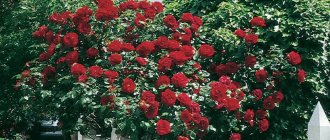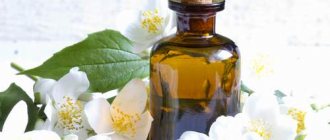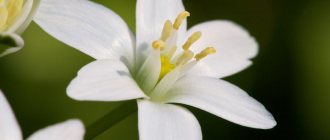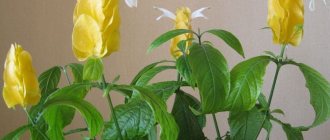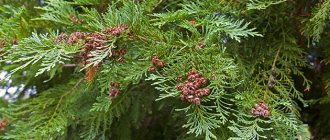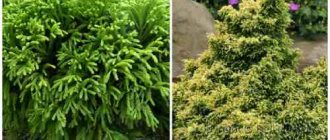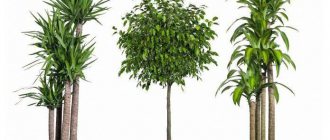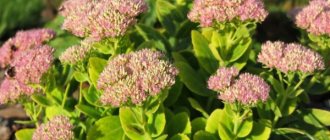From Latin, Sálvia Divinórum is translated as “sage of fortunetellers,” in other words, narcotic sage. The leaves of this plant contain a psychoactive hallucinogen called salvinorin A, which has dissociative properties. As a cultivated plant it bears its Latin name - Salvia Divinorum. This type of sage does not differ in structure from other representatives of the sage genus: a perennial, from the rhizome, first an herbaceous plant, then a subshrub. It grows mainly in the subtropics, but if protected from frost, Salvia Divinorum will survive in colder climates. The ban on growing this plant is due to its properties, which we will discuss later.
Botany
Salvia Divinorum has a densely branched woody root. The stem is simple, ascending, sometimes branched, and has a square cross-section. If it grows in natural conditions, then the bush is quite tall - up to two meters. Again, it propagates vegetatively in natural conditions - by cuttings; any fragments of the stem take root well upon contact with moist soil and give birth to new plants.
The leaves of Salvia Divinorum are large, they reach twenty centimeters, simple, oval, whole, beautiful emerald color, with fine hairs. The edge of the leaf is round-toothed, the leaves are arranged oppositely. The flowers are complex, whorled, typical in shape for all Lamiaceae, the petals are white, the stamens are purple, collected at the end of the stem in spike-shaped inflorescences. The fruit is an ordinary achene.
Salvia: planting and care
Salvia in our latitudes is better known as sage. There are quite a few varieties of this plant, but each of them has unique properties. Ancient people called salvia a flower that prolongs life and bestows knowledge, and today sage can become a wonderful decoration for any garden, even if this garden is laid out on the windowsill of a city apartment.
- Salvia seedlings
Plant Characteristics
Salvia is a perennial plant and the name covers many families and species native to all temperate and subtropical regions except Australia. It got its name from the Latin word “salvus”, which literally means “to be healthy”. Indeed, many of the famous types of salvia have been actively used in folk medicine and shamanism since ancient times.
Speaking of shamanism. There is one variety of salvia that was used (and in some countries is still used) by shamans to enter a state of trance and obtain visions. Salvia Divinorum is prohibited for cultivation in many countries, including Russia, because it can cause visual and auditory hallucinations. In this article we will talk about growing salvia for medicinal and decorative purposes.
Good to know: Medicinal varieties of this plant are called sage, and decorative varieties are called salvia.
In terms of versatility of use and effectiveness of treatment, salvia can only be compared with aloe - this plant can relieve many diseases. For example, a decoction of salvia allows you to quickly and painlessly eliminate the first signs of flux, relieve pain and the development of the disease. There are more than 900 plant species in total, but each of them prefers bright sunny areas, so choose an unshaded place for planting in advance.
Salvia is a rhizomatous perennial plant, but despite this in Russia it is very often grown as an annual or biennial plant. It can easily overwinter under a thick layer of snow in the garden, but in a winter with little snow it will freeze. As for planting salvia at home, you don’t have to worry about this issue. The plant has erect or ascending stems on four sides, the maximum height of which is 120 cm. Green pinnately dissected or whole leaves have a whitish tint on the back side. During the flowering period, spike-shaped or paniculate (depending on the variety) inflorescences up to 20 cm in length appear at the tips of the stems. The bracts are painted in bright colors, for which the decorative qualities of the plant are valued. 25-30 days after the start of flowering, the seeds ripen in the form of 4 nuts, after which they can be collected and stored in a dark, dry place for up to 5 years.
Salvia varieties
Depending on agrotechnical characteristics and biological characteristics, three groups of salvia varieties can be distinguished: American subtropical, Mediterranean and frost-resistant species.
Subtropical varieties in the middle zone are grown as annuals, since they are not able to survive the local winter:
- Sparkling (shiny) - a plant reaching 60-80 cm with lush green foliage, dark green on the outside and light on the back. It has large flowers, collected in tassels of 2-6 pieces, the length of the inflorescence can reach 25 cm. In most cases, the corolla and calyx have a bright red tint, but purple, white and pinkish ones are also found. The flowering period lasts from early June to September. White is distinguished by less dense inflorescences, as well as a cream-colored calyx. Pink salvia has shorter inflorescences than red salvia, and the calyx with a velvety corolla has an even pink tone. However, the most prized is the purple shiny salvia. Because she is very impressive and catchy. The most popular varieties include Fire Star, Red Arrows, Sahara and Salvador.
- Bright red - a bush up to 70 cm high. The leaves are ovoid, petiolate with finely serrated edges. They have short fluff on the back side. The inflorescences are loose and can reach 30 cm in length. They consist of large red flowers with long tubes. Spectacular flowering lasts from early July until frost. The most famous varieties include Sherry blossom, up to 40 cm high, with pink buds, and Lady in Red, with bright scarlet buds.
- Mealy salvia is an unpretentious plant up to 90 cm high, developing in the form of a pyramidal bush. It has oblong leaves with fluff located only along the veins. The inflorescences are small compared to other varieties - up to 20 cm in length. They consist of flowers up to 2 cm in size in quantities from 5 to 25 pieces. This variety is valued for its beautiful and long flowering - dark blue and white corollas delight the eye from early August to late autumn. The most famous varieties: Anschuld with whitish flowers, Strata - small bushes strewn with azure buds, and Victoria, blooming profusely in dark blue.
- Variegated salvia (viridis) - this species has only one decorative variety - Salvia horminum - and all the others are medicinal. Variegated salvia reaches 60 cm in height, has many branching stems with dense, downy foliage. Inflorescences of a simple type are from 18 to 30 cm in length. The bracts have a striking pink or purple color. The most famous varieties: Polar Bear with pink and purple flowers, Pink Sandy with pink and Oxford Blue with bluish-purple.
- Whorled salvia is a compact plant with a maximum height of 40 cm with unusually shaped leaves. A distinctive feature of the flowers is their purple corollas. The Purple Rain variety with purple cups is especially popular.
- Dandelion leaf salvia is a herbaceous variety of salvia with a basal rosette. The peculiarity of the plant is that all its parts exude a pleasant aroma. Leaves with serrated edges are pinnately dissected, bare on top and with down on the back. Inflorescences up to 28 cm in length. Flowers with pinkish corollas and characteristic emerald throats with purple specks.
- Salvia Yurisich - also belongs to the Mediterranean group, but from a decorative point of view it is of no interest.
- Dubravnaya (forest) - a bush up to 60 cm high. The petiolate lower leaves are larger than the upper ones. The inflorescences and several pairs of lateral branches are clusters of 2-6 small flowers with purple corollas. The large purple bracts characteristic of this species delight the eye from mid-June to September. The most popular varieties include Mainakht with blue-violet flowers, Plumaosa with dark lavender flowers, and Amethyst with pinkish-violet flowers.
- Sticky - this type of salvia has taken root best in local latitudes. It can reach a height of 90 cm, has many pubescent stems strewn with long-petioled yellowish leaves with serrated edges. The inflorescences are loose with light yellow flower corollas. The flowering period lasts from August until the onset of frost.
- Lush salvia is a bush that grows up to 60 cm with blue-violet inflorescences. Popular varieties include the miniature Blue Queen and Rose Queen with lilac-blue and pink flowers, respectively, as well as the white Snow Hill.
Mediterranean types of salvia are more resistant to local frosts, but only if there is a snowy winter or prior insulation. They are less whimsical compared to tropical representatives and are better able to tolerate drought and insufficient soil fertilization, and “love” various mineral fertilizers.
The group of Mediterranean salvia varieties includes:
Frost-resistant varieties of salvia mainly grow in warm-temperate climates, but Ethiopian salvia can also be included in this group. These plants are distinguished by abundant flowering, which begins only in the second year after planting in open ground. They are perfect for growing in the Russian climate.
Types of frost-resistant salvia:
How to grow salvia
Growing salvia from seeds is important for one- and two-year-old varieties. Perennials can reproduce both by seeds and vegetatively - by cuttings or dividing bushes. As for the seed method, it can be grown with or without seedlings. In the second case, it is important to know when to sow salvia. In order for it to adapt and germinate on time, it is best to add seeds to the ground in early spring or before the onset of winter, however, these instructions do not apply to all varieties. For example, sparkling salvia can only be propagated by seedlings.
Useful information: You can find both seeds and granules in gardening stores. In addition to the seed itself, the granules contain organic components that increase the growth capacity and endurance of young plants. It should be taken into account that granules germinate more slowly than regular seeds.
Salvia seedlings
If you are going to grow salvia in seedlings, set aside time for this from mid-February to early March. The soil for planting seeds should be loose and moist with a temperature of up to 25C. Sprinkle the seeds with a thin layer of soil and cover the tray with cling film or a plastic bag to create a greenhouse effect and prevent rapid evaporation of moisture.
From time to time, spray the soil with lukewarm water from a spray bottle and cover again with film. The first shoots will appear in 2-4 weeks. After several true leaves appear, the film can be removed and diving can be done. In order for the plants to develop a sufficiently strong root system, this must be done twice. The first dive is carried out when 2-4 true leaves have appeared. Plants are planted in pots at a distance of 5 cm from each other. In this case, the cotyledon leaves need to be buried in the soil. The second dive can be done 20-25 days after the first, planting the salvia in separate pots with a diameter of 10-12 cm.
After the development of 4 and 5 true leaves, the sprouts must be pinched to stimulate tillering. With the onset of April, it’s time to start hardening the seedlings, lowering the temperature at night to +10C.
Planting in open ground
As mentioned above, salvia grows well in light sandy soils, but ideally they should contain lime and humus. The plant needs to be provided with good drainage so that moisture does not stagnate at the roots and provoke putrefactive processes. It is best to plant it in a well-lit area, free from other plants. All types of salvia, with the exception of sticky, can only develop in the sun. The sticky one also feels comfortable in partial shade.
You can plant seedlings in early June, when the night frosts have passed. Planting and caring for salvia is, by and large, no different from working with other garden plants - it needs to be watered as the soil dries, periodically weeding and loosening the soil so that it is saturated with oxygen. For feeding, use universal mineral fertilizers, applying them as needed (usually 2-4 times during the summer). Be sure to feed salvia immediately after planting in open ground and after the buds appear, because Flowering takes a lot of energy from the plant. It is better to water salvia in the evening and not too much so that the water does not stagnate at the roots.
Perennial salvia is a little more hassle than one- and two-year-olds, since it needs to be pruned periodically to form neat bushes. Pruning also promotes lush tillering, preventing the shoots from stretching. When the perennial variety finally fades, it is necessary to remove the remaining fading flowers and perform a “haircut” session before winter dormancy or early spring, when the plant has not yet “woke up”. At the same time, remove woody shoots so as to leave only young areas with buds.
Most types of salvia bloom from mid-June until the first frost, but some varieties manage to bloom twice during the season. So, if after flowering you completely cut off the Forest Salvia and then apply mineral fertilizer, it will bloom again at the end of summer. After the final completion of flowering, prune and mulch the plantings with garden compost to create comfortable conditions for wintering. If the salvia is young, it is recommended to additionally cover it with fallen leaves or spruce branches.
Salvia diseases and pests
Now you know how to grow salvia, and all that remains is to say a few words about its possible diseases and pests. This plant gets sick so rarely that many never encounter such problems in their entire cultivation practice. Pests attack it more often. Usually this is a garden aphid, which, if it appears on the site, indiscriminately affects everything, whiteflies or mites. Salvia can also be damaged by snails and slugs. And while insects can be controlled with insecticides, snails and slugs will have to be caught manually.
Helpful advice: Make a trap for snails and slugs by placing containers of beer or fruit juice around the area - the sweetish smell of fermentation will attract pests like a magnet, and they will lose interest in the leaves of the plants.
Finally, we suggest watching an interesting video about salvia:
Salvia: photo of flowers
More about the plant
The habitat of Salvia Divinorum is not very large in the wild - its homeland is Central America, most of all in Mexico (Oaxaca). This is a fairly water-loving plant that grows well in the shade on regularly moistened and drained soil. It was discovered for the first time in the Sierra Madre region, where it is still used by the Mazatec Indians in shamanic rituals.
In small dosages, the leaves of this plant are used to treat anemia, diarrhea, rheumatism and bloating, and are also taken as a diuretic. That is, Salvia Divinorum is not only a beautiful, but also a useful plant, but the harm from it is much greater, since addiction occurs, and an overdose can result in death.
How to drink sage
Dry yeast benefits and harms.
harm of yeast to the body In order for herbal remedies not to cause harm, they must be consumed in accordance with proven recipes. Drinks based on sage treat many diseases; the plant is especially good at helping against diseases of the genital area.
For infertility
The main property of sage in gynecology is its effective assistance in the treatment of infertility. In order to activate the work of the ovaries, the following scheme is used.
- Immediately after the end of the next menstruation, a woman needs to drink sage infusion twice a day - in the morning on an empty stomach and in the evening shortly before bed.
- You need to use the product before ovulation occurs, usually it comes on the 12th or 14th day of the cycle.
- With the onset of ovulation, therapy is interrupted, and if there is no effect, treatment is continued after the next end of menstruation.
You can take a useful plant for infertility for no longer than 3 months in a row, then you need to take a break for at least 2 months.
Important! If pregnancy does occur, use of the plant should be stopped immediately - it will no longer provide any further benefit.
From frigidity
The benefits of sage seeds and its leaves are expressed in the fact that the medicinal plant helps to cope with female coldness. Dry raw materials are mixed with dried linden in equal proportions, measure out a large spoon of herbal mixture and pour 2 cups of boiling water. The product should be kept in a water bath for half an hour, and then filtered and strained.
You need to drink a glass of the infusion twice a day - the product will raise the level of the female hormone estrogen and help get rid of frigidity.
During lactation
The properties of the plant help interrupt lactation, sometimes this needs to be done earlier than the natural period. Pour a large spoonful of dry herb into a glass of boiling water and leave for half an hour, and then drink 5 sips three times a day.
You need to continue the course for a week. Before starting therapy, the breasts are carefully expressed. Excess milk is also removed if it appears while drinking the infusion.
During menopause
The properties of sage are beneficial during menopause. The infusion is prepared as follows:
- 2 large spoons of raw material are poured into 500 ml of boiling water;
- insist for an hour;
- filter and take 100 ml up to 5 times a day.
If desired, you can add a little lemon juice or honey to this healthy remedy. The medicinal drink relieves nervousness and improves hormonal levels, helps cope with hot flashes and lifts your mood.
For skin diseases
The benefits of the medicinal plant are manifested in a wide variety of skin ailments. Decoctions and infusions are used to wipe purulent wounds and fungal infections; remedies based on medicinal herbs help get rid of eczema and psoriasis.
It is recommended to treat diseased areas of the skin several times a day - this will speed up healing and help the tissues recover.
For problems with the gastrointestinal tract
The properties of the plant are often used to treat flatulence, diarrhea and other gastric disorders. It is necessary to hold 1 large spoon of dry leaves, poured with 500 ml of boiling water, in a water bath for a quarter of an hour. The finished strained drink is consumed four times a day, half a glass, this should be done before meals.
For resolving lumps on hands and feet
Unsightly bumps on the feet and hands cause a lot of problems and spoil the appearance. You can get rid of them with the help of sage - just take healthy baths regularly.
100 g of dry raw materials must be brewed in 5 liters of water and cooked for about half an hour. You can add mullein remedy to the decoction - 100 g of seeds, brewed in 2 liters of water. Keep your feet in a healthy bath for about 15 minutes; you need to repeat the procedure every 2-3 days.
Danger
Even the leaves of ordinary salvia can cause very negative effects when taken in large quantities (usually through smoking): this is not only a bad experience, but also a threat to lung health. Some fans of traveling to other realities do not consider a plant called Salvia Divinorum to be a drug; a ban on its cultivation is considered an inadequate measure.
However, even they admit that traveling to other realities with the help of the sage of fortune tellers can end very badly - a person loses control over himself, can injure himself, fall, or get injured of any severity. Usually, the drug addict gets the main thrill from the end of the action of the Salvia Divinorum extract, since during the action his behavior shows the highest degree of discomfort.
Description of the variety
Salvia Divinorum is a rare narcotic salvia, otherwise known as "predictor's salvia." The flower received this name due to its psychotropic effect on the human body. In its structure, the vegetation does not differ from other species of this category of plants.
From the root the vegetation is herbaceous, but as it grows it takes on the appearance of a shrub. Sage grows in subtropical climates, but if wintered at home, it can be grown in regions with warm summers and cold winters.
The ban on growing this plant variety is related to its chemical properties and effects on the human body. But despite this, sage continues to be grown as house flowers.
Salvia Divinorum has a branched hard root and an aerial part, up to 2 meters in height. At home and in the wild, the plant reproduces vegetatively. Cuttings, when interacting with moist soil, quickly take root and turn into a full-fledged plant.
The leaves on the plant are oblong and oval in shape. They can reach 20 cm in length. Sage flowers form a spikelet at the end of the stem. The petals are white and the stamens are purple. The fruits of the vegetation are ordinary achenes, which contain seeds.
Vegetation is used to treat anemia, increased gas formation, rheumatism and pathologies of the urinary system. Despite the positive effect, the plant provokes the development of addiction and can cause death.
Composition and harm
Sage contains substances that have narcotic effects. The main substances are salvinorin A and B. The plant also contains other fractions of these substances, but their effect on the body has not been studied, and the concentration is extremely low.
Fresh sage leaves contain 0.022% of the narcotic substance, and dried ones - 0.018%.
The harm to the plant is caused by the narcotic substance it contains. Smoking dried herbs leads to a pathological condition of the lungs and causes hallucinations. A person under the influence of drugs completely loses control over himself, which leads to injury.
During the action of salvinorin, a person experiences the highest degree of discomfort, while he is unable to experience and express emotions. Drug addicts use this plant in order to feel the feeling that comes when the effect of the drug ends.
Ban on cultivation
The law of the Russian Federation declared sage a narcotic substance, completely banned its circulation in the country and put it under careful control. The law came into force at the end of 2009. In April of the same year, all flavors and smoking mixtures containing parts of the plant were banned for sale, as they pose a danger to human life.
Sage is also prohibited in countries such as:
- Belgium;
- Germany;
- Denmark;
- Japan;
- Finland, etc.
Not only the active substance is prohibited, but also the plant itself.
The law of Ukraine has officially prohibited the cultivation of sage in the country by any means since May 31, 2010.
Story
For the first time, Salvia Divinorum, the cultivation of which had not yet spread throughout the world, was discovered and described in 1939. And this was done by the scientist Jean Bassett Johnson, who studied Indian shamanism. The scientific discovery occurred even later - in 1962, as a result of the expedition of chemist Albert Hofmann and ethnobiologist Gordon Watson, who went to Mexico specifically to study this plant.
The mechanism of action on the human body was not established until the end of the 90s, when a group of ethnobotanists led by Daniel Siebert began scientific experiments. How Salvia Divinorum was historically cultivated, the law prohibiting which appeared only in some countries, including the Russian Federation, is practically unknown, and it is not possible to study this subject.
Salvia or sage? How to do it right
In fact, salvia is usually called only those plants that are not used for medicinal purposes and are grown only for decorative purposes.
All other species and varieties that are used as folk medicines are usually called sage.
Sage
Salvia
Separately, it is worth highlighting salvia divinorum, which has narcotic and psychotropic properties. It is also called “fortune teller’s sage.” The leaf blades of this type of salvia contain salvinorin, a psychoactive and hallucinogenic substance.
Usage
Due to the small range of this particular species of sage, only one group of Indians used it, and they cannot report how domestication took place.
There is a lot of information about how the leaves of Salvia Divinorum were used by Indian shamans: they chewed them, gradually entering a trance, after which they acquired the gift of clairvoyance and predicted the future. The most experienced ones made a drink from salvia, after drinking which they could guess with 100% accuracy the events already happening and those to come, determine the cause of the illness of the people who turned to them, and even predict their fate.
[edit] Salvia in folklore
There is an opinion that the following anecdote originally appeared somewhere on the forum of a site dedicated to the cultivation of various legal crap and subcultures around it, and looked simply like a comment on another trip report by Salvia:
| Imagine, you have lived 80 years of a pious life, you are dying, on your deathbed, surrounded by relatives and friends (even students)... after 5 minutes three-eyed aliens are around you, snatching a ballulator from your seven-fingered paws, asking: - Well, how did it go? Not a bitch? Is it worth smoking? Tell me what did you see? |
Chemistry
The main psychoactive substances contained in the leaves of the plant are salvinoril A and salvinoril B. They belong to complex organic compounds of diterpenes. Salvia Divinorum also has other fractions of these compounds - C, D, E and so on - six in total, but their concentration is quite small, and the effect on the human body has been practically unstudied. Fresh leaves contain 0.022 percent salvinoril, while dry leaves contain 0.18 percent. The surprise for scientists was that the action is due to the activation of kappa opioid receptors, which is why the psychedelic effect is so great.
Salvinoril A, as it turns out, is the most powerful plant-based hallucinogen known to date. Its potency is ten times greater than psilocycin, and in terms of psychedelic activity it is close to the semi-synthetic hallucinogen known to everyone as LSD. Perhaps this information is slightly exaggerated by the advertising campaign waged by distribution agents who are doing everything to seduce the youth of our country from the path of a healthy lifestyle.
Photo and description of sage
What is tobacco, its origin, cultivation and use
Sage is easy to recognize. The plant is a low shrub, up to 60-70 cm high, with small leaves on tetrahedral stems, abundantly strewn in the upper part with many purple flowers.
Flowers can be not only purple, but also blue, white, pink, with their various shades.
The herb Salvia officinalis belongs to the Lamiaceae family and has a huge variety of species. In total, there are more than 1000 species and cultivated varieties of grass in the world, and all of them are used in the garden, in the kitchen, in medicine, and cosmetology.
It is not for nothing that in different countries and eras the plant was called the herb of immortality.
Wild sage bushes on the mountainous slopes of Greece
In ancient Egypt, women were given an infusion of the herb to improve fertility. In China, a box of dry leaves was worth two boxes of tea in the 16th century. In Europe in the Middle Ages, they even fought the plague with the help of this medicinal herb.
Fragrant purple sage flowers
The Mediterranean is considered the birthplace of sage. The first information about the plant appeared in Ancient Rome and Greece. There are references to it in the works of Pliny the Elder and Hippocrates. An infusion of the immortal herb is known as Greek tea.
As you can see, this is a heat-loving plant and in our latitudes, especially in harsh winters, it may not survive, even if you have cold-resistant varieties.
Chemical composition of sage
One teaspoon of dry herb contains 2.5 grams of nutrients. The herb contains essential oils - salvin and uvaol, as the main active ingredients.
The plant owes its peculiar but pleasant smell to essential oils. Sage smells like thyme, only more delicately, especially the dry herb, but in a decoction, salvia is very bitter and astringent, unlike thyme.
There are vitamins A, C, E, rare vitamin K, necessary for the synthesis of proteins in the body, nicotinic acid, “fashionable” linoleic acid (Omega-6), ursolic acid, tannins. Sage contains minerals such as potassium, magnesium, zinc, iron and phosphorus.
Thanks to its chemical composition, salvia officinalis has a beneficial effect on humans, counteracts the proliferation of pathogenic organisms, and has a bacteriological effect.
Ban
Since 2009, Salvia Divinorum has been included in List 1 of the List of Narcotic Drugs. The law of the Russian Federation classifies it as psychotropic substances and their precursors, which are subject to control, and their circulation is completely prohibited. In April 2009, by a decree of the sanitary doctor of the Russian Federation, smoking mixtures and flavors containing sage of fortune tellers were banned due to the content of toxic substances in its composition.
Also, this plant and its component salvinoril A are included in the lists of controlled substances in many other countries - Belgium, Australia, Germany, Italy, Denmark, Spain, Sweden, Finland, Japan and some US states. These states have banned both salvinoril and the plant itself, called Salvia Divinorum.
Biological description
Diviner's sage inflorescence
Salvia divinorum
does not have significant differences in structure from other representatives of its genus. Rhizomatous, perennial, in the initial period - herbaceous, and then - a semi-shrub plant. Grows in subtropical climates. In the absence of frost it grows throughout the year.
The root is woody, with a dense branching system.
The stem is ascending, simple or branched, with a square cross-section, and in natural conditions reaches a height of 1.5-2 meters. Under natural conditions, vegetative propagation by cuttings occurs - fragments of the stem, upon contact with moist soil, take root and give rise to new plants.
The leaves are simple, entire, oval in shape, can reach 20 cm. They have an emerald green color and are covered with short hairs. The edge of the leaf is round-toothed. The arrangement of the leaves is opposite.
The flowers are complexly whorled, with a typical Lamiaceae shape, with white petals and purple stamens. At the end of the stem they are collected in spike-shaped inflorescences.
The fruit is a coenobium.
This is interesting: Rudbeckia Golden Ball - we explain in detail
Growing
This flowering plant is almost impossible to propagate by seeds; most often the grower will face failure. But the cuttings take root perfectly. Even if a twig of five to ten centimeters, spontaneously breaking off, falls on damp and soft ground, it takes root. Under cultural conditions, cuttings are rooted either in water or in favorable substrates, for example river sand. To do this, take a small pot or even a plastic cup, fill half of it with soil, into which freshly cut Salvia Divinorum is planted two to three centimeters deep, the cuttings of which are covered with a glass container or a plastic bag.
It is better to keep the plant in the shade until it takes root, then after a couple of weeks you can begin to lightly feed it. The roots grow very quickly, occupying the entire space of the container, so it is undesirable to delay replanting. It is better to replant into a much larger container. An adult Salvia Divinorum, the seeds of which some amateur plant growers still manage to germinate, requires a very large pot, as well as regular feeding. However, it is important not to overdo it. Salvia Divinorum is very sensitive to overdose.
Possible problems in growing
The plant is an unpretentious flower. Not susceptible to disease, but sometimes you can find species affected by all kinds of pests.
Pests
Parasites that harm flowers include:
- Common whitefly.
- Thrips.
- Aphid.
- Mite.
- Snails or slugs.
There are a huge number of special preparations on the market that will help cope with pests. But snails and slugs can only be removed manually or using special homemade traps.
Diseases
The main factor why gardeners love salvia is its resistance to almost any disease.
Signs of improper care
Why doesn't salvia bloom? Most often, the reason is failure to comply with basic care rules. The appearance of parasites on the plant is the first sign of improper care of salvia.
If the flowers begin to turn yellow ahead of time, this means that the plant lacks trace elements. You can save the situation by watering it with any complex fertilizer.
Once having decided to plant salvia on his plot, even a novice amateur gardener will not regret his choice for a second. Just remember that caring for the salvia plant should be regular and timely.
Exclusive
The one-of-a-kind flower is grown in the country quite often, although Divinorum is almost not present; simply sage is welcomed, which also has many romantic names, for example, life-prolonging. The homeland of the common Russian dacha plant is considered to be the south of Europe, where it is also a sacred herb and has considerable medicinal properties.
Hippocrates called the healing properties of sage life-saving, and the ancient Egyptians used it to rejuvenate the body and use its effect on childbirth. When the bloody wars ended, sage was brewed in every kitchen and added to all dishes - the ability to conceive increased, the population was restored and grew. In addition, some magical properties were attributed to sage, especially in Ancient Egypt. And now both children and adults are treated with sage for any cold, cough, toothache, or inflammation of the oral mucosa.
How to store seasoning
Growing tobacco at home
Since it is not customary to grow sage in our country, you can rarely find green bunches of its leaves on the open market. If the grass is grown on your own plot, you can dry the leaves yourself - using an electric dryer or oven at natural temperatures of 40°C. For these purposes, the leaves are collected during the period of active flowering of the plant - then they are filled with essential oils, but do not yet become sharp and heavy in taste.
You can purchase a ready-made seasoning - chopped sage in the form of small flakes. This spice is packaged in foil bags, less often in opaque film bags. The crushed spice should be poured into a ceramic or glass jar with a tight lid and stored in the shade.
Sometimes in spice shops you can find knitted dried sage, which, as a rule, is sold not for culinary purposes, but as a flavoring agent. Such a bundle should be stored in a linen bag in a dry place where there are no foreign odors.
Thanks to its intense aroma, the spice does not lose its properties for a long time and does not dry out, so it can be stored in a closed container for several years.
Species diversity
Salvia Divinorum is a type of sage, a perennial, in harsh climates it loses this quality and lives for two years at most, since it does not tolerate frost. As it is on the list of prohibited plants due to its strong hallucinogenic effect, it cannot be grown in the countryside, since this is prohibited by law.
Salvia sparkling (shiny) - in beauty it is absolutely not so simple, it can be compared with the inflorescences of a plant such as Salvia Divinorum, photo of flowers. Its seedlings are grown from seeds to decorate any flower bed: not very tall, up to fifty centimeters, bushes with white, pink, purple panicles. And this is not a perennial plant in our latitudes, most often it is annual, sometimes biennial.
Salvia sparkling seeds are germinated in the same way as cosmos or chamomile. The sowing is covered with glass in order to create a microclimate and keep the soil moist. It is better to water with a spray bottle so as not to accidentally wash out the seeds. After two or four weeks, shoots appear. The shoots are extremely small and delicate. Too dense shoots need to be thinned out, but carefully, preferably with tweezers, because neighboring plants are easily damaged. At first, salvia grows very, very slowly. If the sprouts become very elongated and thin, add moist soil under them, as if gently hilling them up. After the real leaves appear, salvia will require much less care. But only when spring frosts are completely over can seedlings be planted in open ground.
Other types of sage include desert salvia, Dagestan, Syrian, Transylvanian, ferruginous, prickly, meadow, etc.
Kinds
There are more than 900 varieties of this culture, but they are classified only into 3 groups.
First group
This group includes heat- and moisture-loving plants that cannot tolerate frost. It is clear that in the climatic conditions of our country this type of plant is an annual.
Salvia sparkling belongs to this category . Its flowers have the following shades: red, white, pink and purple. The buds form inflorescences of 2-6 pieces, and reach a diameter of 15-25 cm. The bush is compact, no more than one meter high. Flowering begins in early summer and ends only with the onset of the first frost.
The first group also includes “Salvia bright red” . It, unlike the sparkling one, begins to bloom later - from July until the first cold weather. The bush reaches a height of 70 centimeters. Inflorescences are formed from a large number of buds and reach a diameter of 30 cm.
"Salvia mealy" begins to bloom even later - in August. It also blooms until the first frost. The color of the inflorescences of 28 buds is snow-white or blue. Diameter 20 centimeters. The bush reaches a height of 90 centimeters.
Second group
The 2nd group includes only those varieties that can tolerate drought and colder climates, although they are also annuals.
Despite their relative unpretentiousness, plants from this category require more careful care. They need regular feeding with mineral fertilizers.
The second group includes “Green Salvia” . The color of the inflorescences is pink or purple. The height of the bush is only 60 centimeters, the diameter of the inflorescences is about 30 centimeters.
“Salvia whorled” from the 2nd group is a low-growing plant with modest dimensions, not exceeding 40 centimeters. Inflorescences are formed from buds, numbering from 5 to 30 pieces. The color is lilac or violet.
Also included in the 2nd group is “Salvia dandelionifolia” . The inflorescences have a pink or purple tint.
Third group
These are frost-resistant, unpretentious plants. Active flowering in representatives of this group, as a rule, begins only in the second year, so pay close attention to their wintering.
The third group includes "Salvia oak" , blooming from early summer to early autumn. A small shrub reaches a height of 60 centimeters. Inflorescences are formed from 6 buds of blue or purple shades.
"Salvia adhesive" has bright yellow inflorescences. The height of the bush is 90 centimeters. It blooms late - from August until the first frost.
"Salvia Caradonna" from the same group is quite compact. The bush reaches small dimensions from 30 to 60 centimeters. The inflorescences are long, graceful, and purple. Blooms from late June to September.
Care
This plant is a whim, so growing it in the country is not an easy task. Attention and care are needed constantly. And also the absence of through winds. Salvia loves the sun, but also grows well in the shade. The soil should be rich and moisture-absorbing. Acidic soil is preferable. Weeding and loosening of the soil is required. This ornamental shrub blooms from June until frost - the joy of any gardener. Therefore, it is better to water this plant at the root and as needed.
Loves moisture, but there should not be stagnation of water. In addition to peat, sand is also added to the soil so that the water does not stagnate. Fertilizing is carried out repeatedly with both complex and mineral fertilizers. First, the seedlings are fertilized, then during the budding period. Growth stimulants (for seedlings) have performed well. Protection from pests - mites, aphids and thrips - is also necessary. Salvia gets sick extremely rarely.
How does salvia reproduce?
Annual and biennial species reproduce by seeds. Perennial salvia can be propagated by seeds, dividing the bush or cuttings.
For your information! Collected seeds can be stored for 5 years.
Growing from seeds
The most reliable way to sow seeds is for seedlings. Frost-resistant varieties can be sown in autumn or early spring directly into the ground.
Selection of capacity
To maintain the same growth conditions, seeds are sown in one or more boxes. It is necessary to line the bottom with a layer of expanded clay.
Preparing soil and seed
Light soil is needed. It is advisable to purchase a special one for seedlings. You can mix peat, sand and leaf soil yourself. The seeds are very small; for ease of sowing, they are mixed with sand.
Note! Some manufacturers make pellets with a seed in the center. As a shell - growth-stimulating drugs
Seedling care
After sowing the seeds on moist soil, the box is covered with glass. The soil temperature during planting should be at least 25 °C. During further maintenance, the temperature should be maintained in the range of 20-25 °C.
After seed germination, the box is moved to a sunny place, providing 12 hours of daylight (with artificial lighting).
Humidity levels should be kept moderate. If there is excess moisture, the sprouts quickly rot. When the soil dries out, they wither and die.
Dive and transfer
When the salvia produces two true leaves, it needs to be transplanted into individual pots.
To prevent shoots from stretching, it is important to ensure uniform lighting and day length
Important! After the third pair of leaves, the bush is pinched for fullness.
Sage seedlings
When the ground warms up and the likelihood of frost has passed, the seedlings can be transplanted into flower beds. You should first harden the young salvia. To do this, you need to take the seedlings out into the open air, first for 10-20 minutes, increasing the time each time.
For the flowerbed, you should choose a sunny place with light soil. It is better to plant by transshipment at a distance of 30 cm between the bushes.
Propagation by cuttings
Cuttings should be semi-lignified and only perennial varieties. A 15 cm long branch must be cut and placed in water. The roots appear quickly - on days 14-16. You can plant in open ground a week after the roots appear.
Young cuttings should be cared for with special attention
Note! Salvia is propagated by cuttings throughout the season.
Planting salvia
It is difficult to give general recommendations for growing salvia, because this plant has many species that differ so much from each other: some love the sun, others love shade, others love partial shade, some are drought-resistant, others love moist soils, and so on. But despite this, there are many similarities between the species. So, all cold-resistant salvias feel equally good not only in partial shade, but also in the sun. Heat-loving species, on the contrary, can grow normally only in sunny areas, they are not so demanding on soil moisture and are more drought-resistant, keep this in mind when planting.
When planting, place different species as far apart as possible. When choosing a place for planting, remember that all of them, regardless of the species, prefer to grow on light sandy soils, relatively rich in humus. And I almost forgot, salvias very easily cross with each other, which is why they are not suitable for further propagation by seeds. Therefore, try to place different types of salvia as far from each other as possible.
